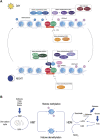Histone methylation: at the crossroad between circadian rhythms in transcription and metabolism
- PMID: 38818037
- PMCID: PMC11137191
- DOI: 10.3389/fgene.2024.1343030
Histone methylation: at the crossroad between circadian rhythms in transcription and metabolism
Abstract
Circadian rhythms, essential 24-hour cycles guiding biological functions, synchronize organisms with daily environmental changes. These rhythms, which are evolutionarily conserved, govern key processes like feeding, sleep, metabolism, body temperature, and endocrine secretion. The central clock, located in the suprachiasmatic nucleus (SCN), orchestrates a hierarchical network, synchronizing subsidiary peripheral clocks. At the cellular level, circadian expression involves transcription factors and epigenetic remodelers, with environmental signals contributing flexibility. Circadian disruption links to diverse diseases, emphasizing the urgency to comprehend the underlying mechanisms. This review explores the communication between the environment and chromatin, focusing on histone post-translational modifications. Special attention is given to the significance of histone methylation in circadian rhythms and metabolic control, highlighting its potential role as a crucial link between metabolism and circadian rhythms. Understanding these molecular intricacies holds promise for preventing and treating complex diseases associated with circadian disruption.
Keywords: chromatin; circadian rhythms; epigenetics; histone methylation; metabolism; transcription.
Copyright © 2024 González-Suárez and Aguilar-Arnal.
Conflict of interest statement
The authors declare that the research was conducted in the absence of any commercial or financial relationships that could be construed as a potential conflict of interest.
Figures


Similar articles
-
Mammalian molecular clocks.Exp Neurobiol. 2011 Mar;20(1):18-28. doi: 10.5607/en.2011.20.1.18. Epub 2011 Mar 31. Exp Neurobiol. 2011. PMID: 22110358 Free PMC article.
-
Circadian rhythms in the tissue-specificity from metabolism to immunity: insights from omics studies.Mol Aspects Med. 2021 Aug;80:100984. doi: 10.1016/j.mam.2021.100984. Epub 2021 Jun 20. Mol Aspects Med. 2021. PMID: 34158177 Review.
-
Circadian Regulation of Metabolism: Commitment to Health and Diseases.Endocrinology. 2023 Jun 6;164(7):bqad086. doi: 10.1210/endocr/bqad086. Endocrinology. 2023. PMID: 37253106 Review.
-
Circadian rhythms in the three-dimensional genome: implications of chromatin interactions for cyclic transcription.Clin Epigenetics. 2019 May 15;11(1):79. doi: 10.1186/s13148-019-0677-2. Clin Epigenetics. 2019. PMID: 31092281 Free PMC article. Review.
-
Circadian rhythms, the molecular clock, and skeletal muscle.J Biol Rhythms. 2015 Apr;30(2):84-94. doi: 10.1177/0748730414561638. Epub 2014 Dec 15. J Biol Rhythms. 2015. PMID: 25512305 Free PMC article. Review.
References
Publication types
Grants and funding
LinkOut - more resources
Full Text Sources

